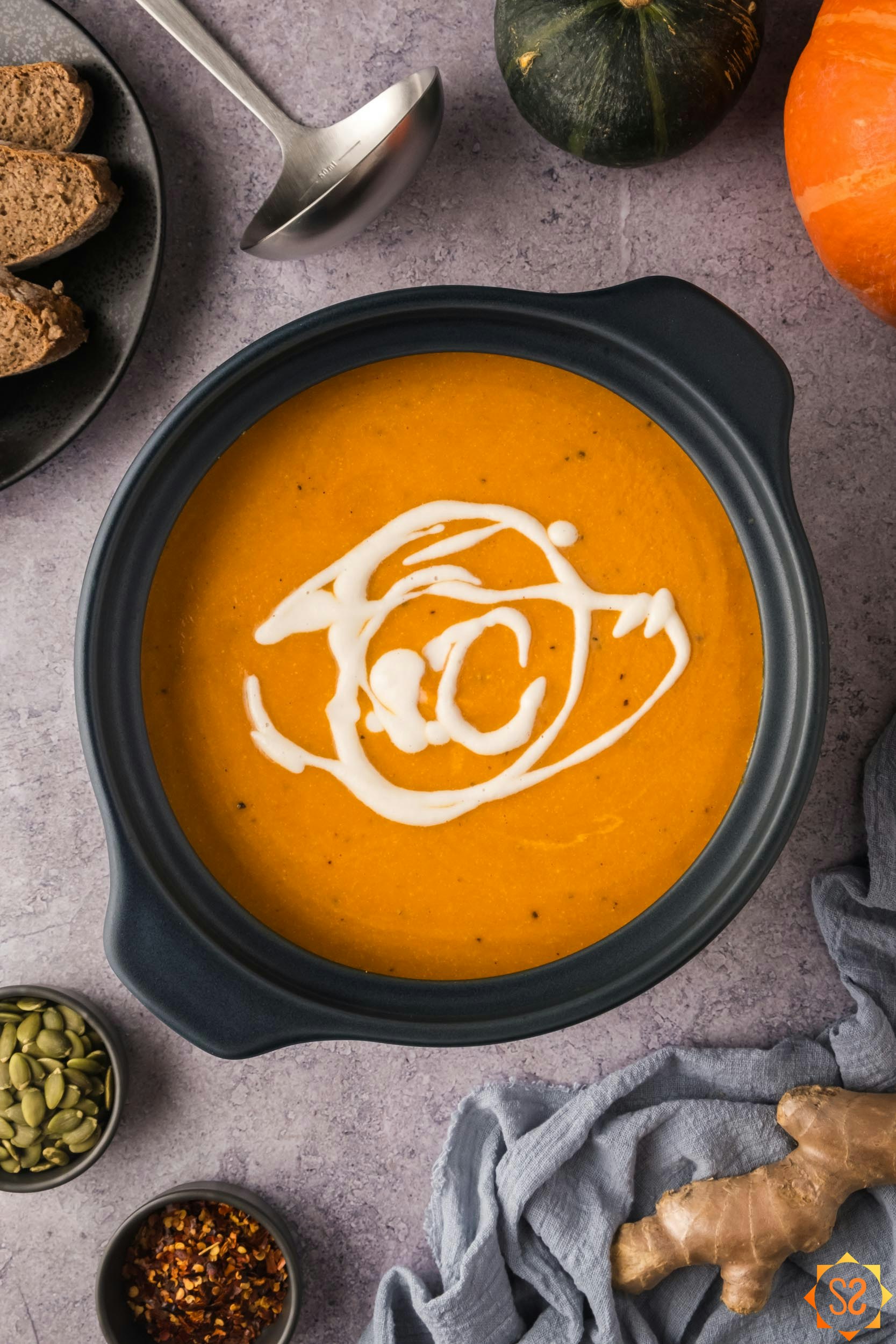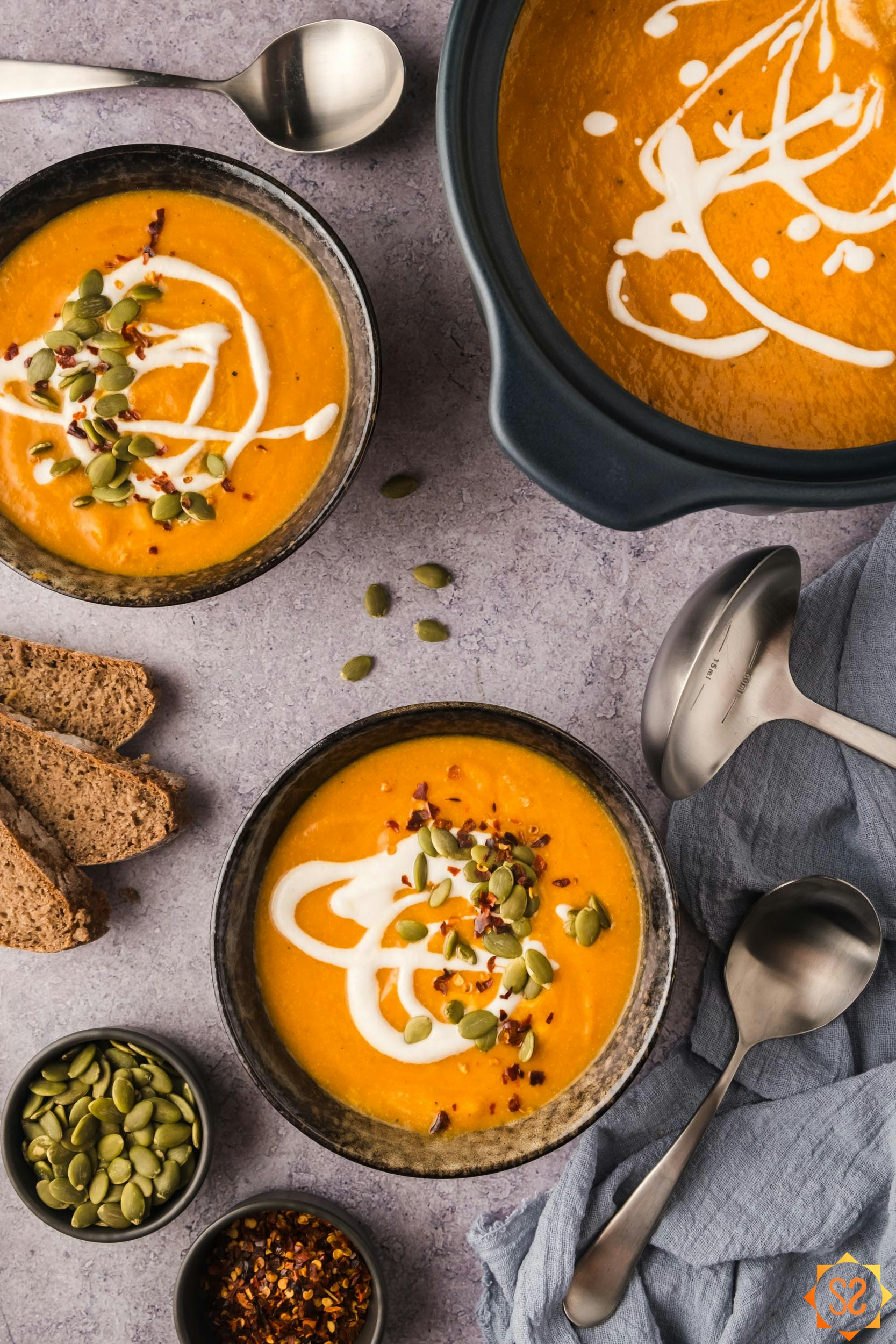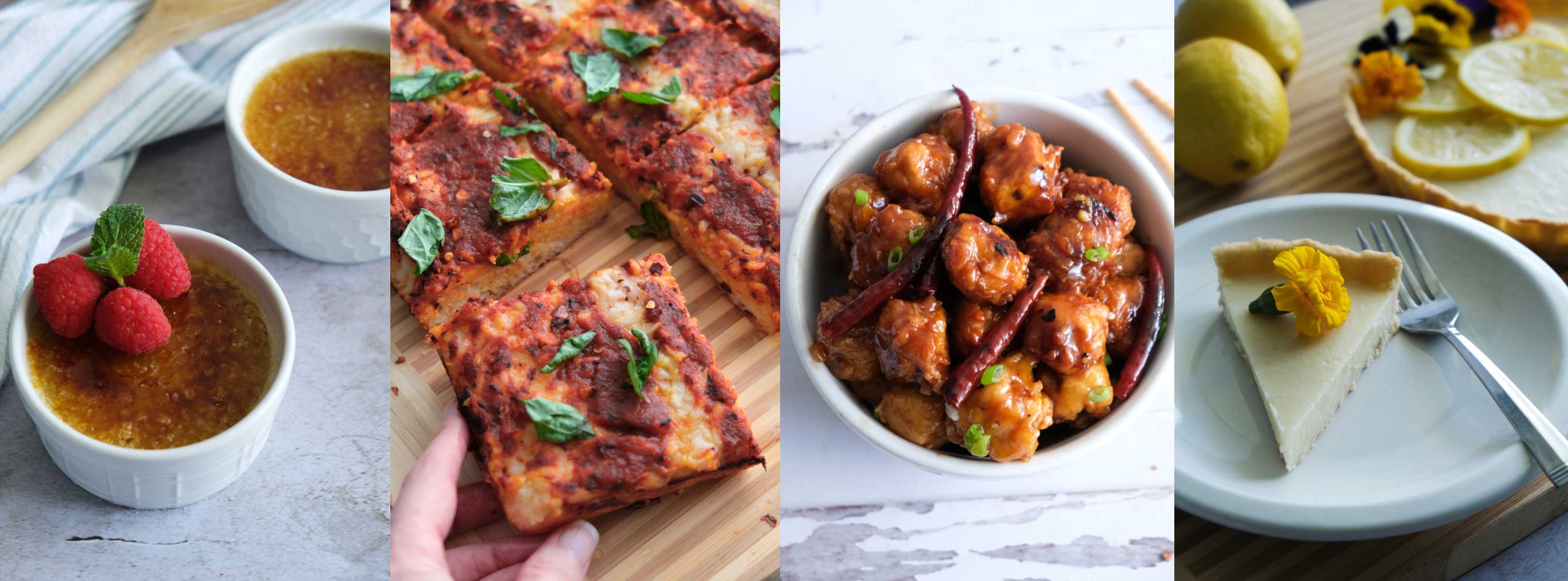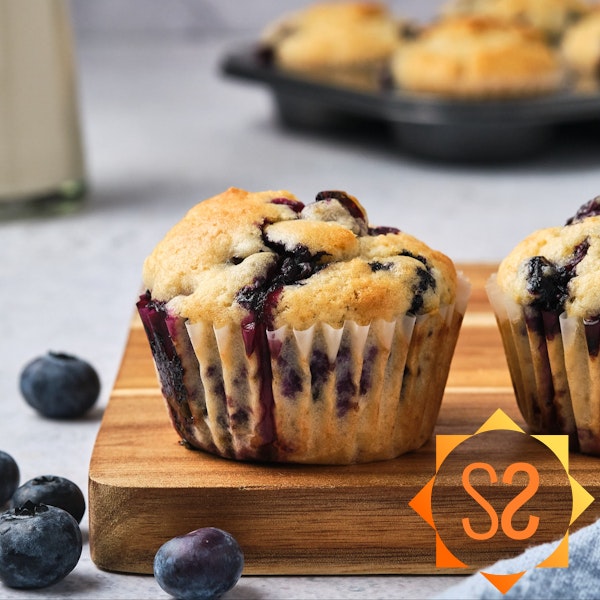Creamy Carrot Pumpkin Soup
Published: November 2, 2021
Modified: February 13, 2024
This carrot and pumpkin soup is the perfect cozy meal for cool fall nights. The slight sweetness of the pumpkin and carrot pairs perfectly with the warm spiciness of cinnamon, nutmeg, ginger, and red pepper. Added cashew cream takes this vibrant soup to the next level of creamy deliciousness!
This soup is also easy to make (just chop, simmer, and blend), and makes plenty for leftovers. Pair it with some toasty, crusty bread, and curl up on the couch with a blanket for the ultimate fall comfort!

Ingredients & Substitutions

Low-sodium vegetable broth: I recommend low-sodium broth so you can add salt to taste; if you can only get regular vegetable broth, leave out the salt.
Ground cinnamon: adds warm, earthy notes to the pumpkin's sweetness.
Ground nutmeg: slightly sweet, nutty flavor; you can also grind fresh nutmeg for enhanced flavor.
Crushed red pepper flakes: adds a bit of heat to the soup; you can adjust the amount or leave it out entirely to suit your taste.
Sugar (pie) pumpkin: any type of butternut squash or pumpkin made for eating will work, but don't use a carving pumpkin since those are watery and lack flavor.
Carrots: make sure you choose fresh, firm carrots for the best flavor.
Ginger root: adds a bit of spiciness to the soup; older ginger is spicier than fresh ginger. You could also use ground ginger here, but it won't be quite as delicious.
Raw cashews: soak your cashews in hot water for 10 minutes before blending with water. The cashews make for a creamy, luxurious soup texture and provide a slightly earthy flavor. For a nut-free version, use canned coconut cream in place of the cashew cream.
Water: for blending together with cashews; I recommend filtered water.
Salt & black pepper: enhances the flavors of the soup; add to taste.

How to Cut a Pie Pumpkin
Cutting a pumpkin is not too difficult, but it might require a little muscle. You'll also need a vegetable peeler and a strong, sharp knife.
If your pumpkin is wide, you can cut the pumpkin in half, just to the side of the stem. My pumpkin (shown below) was tall, so I cut the stem off first, then cut the pumpkin in half.
After cutting your pumpkin in half, use a large spoon to scoop out the seeds and stringy insides. Then cut the halves into 6 smaller wedges. If you didn't cut the stem off earlier, cut it off now.
Next, use a vegetable peeler to remove the skin. The skin of my pumpkin was pretty thick, so I had to peel it twice to get the inner layer removed. Finally, chop the pumpkin into 1.5-inch chunks.

Storing, Reheating, and Freezing Leftovers
Leftovers can be kept in an airtight container in the refrigerator for 3-5 days. Reheat in a saucepan over medium heat, stirring until heated throughout.
For longer storage (up to 6 months), freeze the soup in a freezer bag or other freezer-safe container. Leave space in the container for the soup to expand as it freezes. You may wish to freeze the soup in individual portions so you can defrost only what you'll eat. You can defrost the soup in the refrigerator overnight, or immerse the container in hot water until it thaws. Then, reheat as usual.

Serving Suggestions for Carrot Pumpkin Soup
Toppings: The bright color of this soup lends itself to a delicious array of toppings. I like to add a swirl of cashew cream, pepitas (pumpkin seeds), and red pepper flakes. You can also try:
fresh herbs or microgreens (thyme, sage, rosemary)
croutons
nuts: walnuts, pecans, cashews, pine nuts
seeds: hemp seeds, pepitas
ground spices: cinnamon, nutmeg, cloves, allspice
cream: cashew cream, coconut milk
dried fruit: cranberries, raisins

Delicious pairings: although this soup is amazing on its own, dunking a slice of crusty sourdough bread is even better. You can also enjoy it together with side dishes or as a side to a main dish. Here are some suggestions:
Check out my list of must-try vegan fall recipes for even more ideas, including dinner, breakfast, and desserts.
Frequently Asked Questions
Can I make this nut-free? Sure, just substitute the cashew cream for 1 cup of canned coconut cream (or you can use the thick cream from the top of a can of full-fat coconut milk). This may result in a thinner soup, so before you blend your ingredients, remove 1 cup of vegetable broth, then add in your coconut milk or cream. If it's too thick after blending, then you can add more vegetable broth until you reach your desired consistency.
What kind of pumpkin should I use? Sugar pumpkins (also known as pie pumpkins) are the variety I used in my soup, and I've also made this recipe with other varieties of small pumpkin and butternut squash. Any sweet pumpkin will work, but avoid the large pumpkins that are used for carving, as those don't have much flavor and the texture is a bit watery.
Can I use canned pumpkin puree instead of fresh pumpkin? Fresh pumpkin will give you the best flavor, but pumpkin season is short. If you can't get fresh pumpkin, you could either substitute with fresh butternut squash, or use about 1 1/2 15-ounce cans of pumpkin puree. Canned pumpkin is already cooked, so you don't need to cook it together with the carrots and broth. You can just add it in before blending.
Can I eat the pumpkin seeds? Yes, pumpkin seeds are edible, although some people don't like them because they're a bit woody in texture. To separate them from the pulp, wash them off in a bowl of water. Then, transfer them to a baking sheet to dry. By the next day, they should be dry enough to bake. Spray them with a bit of olive oil spray (or toss with a small amount of olive oil). If you want to, you can also sprinkle them with a bit of salt. Bake at 325°F (160°C) for about 15-20 minutes, stirring the seeds every 5 minutes or so.

Creamy Carrot Pumpkin Soup
Yield9 1/2 cups (5 servings as a main course, 10 servings as a starter)
Prep Time30 minutes
Cook Time30 minutes
Total Time1 hour
Ingredients
- 5 1/2 cup low-sodium vegetable broth
- 1 tsp. ground cinnamon
- 1/2 tsp. ground nutmeg
- 1/2 tsp. crushed red pepper flakes*
- 21 oz. sugar pumpkin (pie pumpkin) cubes (from about 1 medium 2-lb/900-g. pumpkin, peeled and seeded)
- 1.5 lbs. carrots, peeled and chopped
- 1 tsp. fresh ginger root, peeled and grated
- 3/4 cup raw, unsalted cashews, soaked*
- 3/4 cup water
- 2 tsp. salt (to taste)
- 1 tsp. black pepper (to taste)
Instructions
Add your vegetable broth to a large stock pot (or saucepan) over medium heat. Add in your cinnamon, nutmeg, and red pepper flakes, and whisk together.
![Vegetable broth and seasonings mixed in a pot.]()
Add your pumpkin cubes, chopped carrots, and grated ginger to the pot and turn up the heat to bring to a boil. Reduce the heat to medium-low, cover, and simmer for 30 minutes.
![Carrots, pumpkin, and ginger added into the pot with broth.]()
While your vegetables are cooking, prepare your cashew cream. Combine soaked cashews and water in a blender and blend until smooth, then set aside.
![Blended cashew cream in a blender.]()
Blend up the contents of your pot until smooth and creamy using an immersion blender (handheld stick blender). You can also transfer the broth and vegetables to a standard blender to blend, then transfer back to the pot. (If you’re using a standard blender, you will likely have to do this in batches. Be sure to remove the center piece from your blender top to allow steam to escape, and cover with a kitchen towel or paper towel to prevent splattering.)
![Broth and vegetables blended in a blender jar.]()
Measure 1 cup of cashew cream and mix it into the soup. If you have an immersion blender, you can use it again, otherwise mix by hand. Gradually add salt and pepper to taste. I used 2 teaspoons of salt and 1 teaspoon of pepper.
![Stirring cashew cream into the carrot pumpkin soup.]()
Allow to cool slightly (or reheat on the stove, if needed), then transfer to bowls to serve. Garnish with a swirl of the remaining cashew cream, and your choice of red pepper flakes, pepitas (pumpkin seed kernels), or fresh herbs like thyme, sage, or rosemary. See the post above for more topping and serving suggestions.
Notes & Hints
If you don't want a spicy soup, omit the red pepper flakes. You can also increase the red pepper flakes for more heat.
Soak cashews in hot water for 10 minutes before blending.
Leftovers: Store in an airtight container in the refrigerator for 3-5 days. Reheat in a saucepan over medium heat, stirring regularly, until warm. See the post for freezing instructions.
Nutrition Data
Serving Size: 1/5 of recipe; Calories: 233; Fat: 11 g.; Saturated Fat: 2 g.; Cholesterol: 0 mg.; Sodium: 1150 mg.; Carbohydrates: 32 g.; Fiber: 7 g.; Sugar: 15 g.; Protein: 6 g.; Vitamin A: 518 mcg. RAE; Vitamin B12: 0 mcg.; Vitamin C: 18 mg.; Vitamin D: 0 mcg.; Calcium: 101 mg.; Iron: 3 mg.; Potassium: 1161 mg.; Zinc: 1 mg.Note: This data should be used only as an estimate. Please see the nutrition section of my terms and conditions for more information on how this data is calculated.
Vegan recipes in your inbox
Join the community and get my newest and best yummy vegan recipes sent right to your email!

Share this:























Leave a Comment
I love reading comments! I'll do my best to answer questions, too. If you made the recipe, please leave a star rating, it helps support the blog so I can make more recipes and articles. Thank you!
says